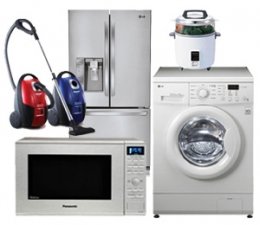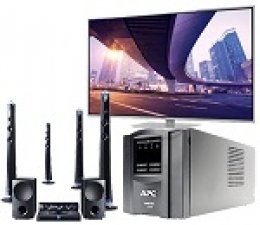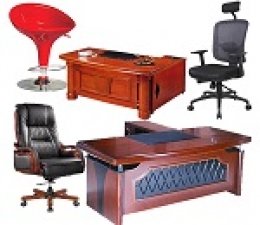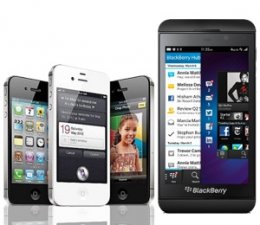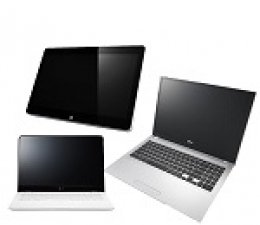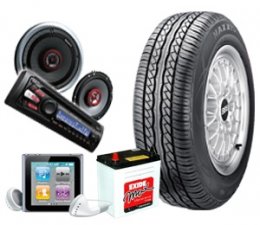DESKTOP COMPUTER
A desktop computer is a personal computer in a form intended for regular use at a single location desk/table due to its size and power requirements, as opposed to a laptop whose rechargeable battery and compact dimensions allow it to be regularly carried and used in different locations. The most common configuration is a computer monitor, keyboard and mouse, and a case that houses the main components of the PC, namely the power supply, motherboard, hard drive, optical drive, and previously the floppy drive. The form factor of the case is typically an upright tower or (horizontal) desktop. All-in-one computers, that integrate the monitor and main PC components in one unit, are often categorized under the desktop computer umbrella, particularly if they require an external power source and separate keyboard/mouse. The desktop category has also encompassed home computers and workstations.
Origins
Prior to the widespread use of microprocessors, a computer that could fit on a desk was considered remarkably small; the type of computers most commonly used were minicomputers, which were themselves desk-sized. Early computers took up the space of a whole room. Minicomputers generally fit into one or a few refrigerator-sized racks.
The very first "programmable calculator/computer" was marketed in the second half of the 1960s, starting with the Italian machinery Programma 101 (1965) computer at typewriter size. More desktop models were introduced in 1971, leading to a model programmable in BASIC in 1972. This one used a smaller version of a minicomputer design based on read-only memory (ROM) and had small one-line LED alphanumeric displays. They could draw computer graphics with a plotter.
Growth and development
Throughout the 1980s and 1990s, desktop computers became the predominant type, the most popular being the IBM PC and its clones, followed by the Apple Macintosh, with the third-placed Commodore Amiga having some success in the mid-1980s but declining by the early 1990s.
Early personal computers, like the original IBM Personal Computer, were enclosed in a "desktop case", horizontally oriented to have the display screen placed on top, thus saving space on the user's actual desk, although these cases had to be sturdy enough to support the weight of CRT displays that were widespread at the time. Over the course of the 1990s, desktop cases gradually became less common than the more-accessible tower cases that may be located on the floor under or beside a desk rather than on a desk. Not only these tower cases had more room for expansion, but also they have freed up desk space for monitors which were becoming larger every year. Desktop cases, particularly the compact form factors, remain popular for corporate computing environments and kiosks. Some computer cases can be interchangeably positioned either horizontally (desktop) or upright (mini-tower).
Components
An entire computer that sits on a desk or table, a PC or Macintosh being examples. It usually consists of: a display, either color or monochrome; a system box containing the processor, memory, disk drives, power supply, and communication interfaces; a keyboard; a pointing device, often a mouse. Although the desktop computer is relatively cumbersome compared with a notebook computer of equivalent power, it currently has a significantly better power/performance ratio.
Part of a graphical user interface which invites the user to imagine that some or all of the screen is an actual desktop on which actions analogous to those occurring on a physical desktop can be carried out. These include the opening and closing of folders, the entry and modification of text, the disposal of unwanted material into a wastebasket, and the use of communication systems analogous to telephones and mailboxes. The analogy is supposed to make life easier for office workers unused to computers.
All-in-one
An all-in-one desktop computer integrates the system's internal components into the same case as the display.
Advantages of the all-in-one form factor
Simplicity and ease of setup (some connecting cables are eliminated)
Smaller footprint
Increased portability
Disadvantages of the all-in-one form factor
Typically has few or no expansion slots
Difficult or impossible to upgrade the display (for example, from a standard display to a 4K display)
If the display fails, cannot simply connect a spare unit while retaining the advantages of an all-in-one
Vendor lock-in (due to their integrated nature, major components of the system must be purchased from the same manufacturer)
Increased cost (for example, the performance and functionality of an iMac can often be obtained at lower cost by connecting a Mac Mini to a generic display)
The all-in-one form factor was popular during the early 1980s for computers intended for professional use such as the Kaypro II, Osborne 1, TRS-80 Model II and Compaq Portable. Many manufacturers of home computers like Commodore and Atari included the computer's motherboard into the same enclosure as the keyboard; these systems were most often connected to a television set for display. Apple has manufactured several popular examples of all-in-one computers, such as the original Macintosh of the mid-1980s and the iMac of the late 1990s and 2000s. By the early 2000s, many all-in-one designs were using flat panel displays, and by late 2012 some all-in-one models also included touchscreen displays to accommodate Windows 8.
Some all-in-one desktops such as the iMac G4 have used laptop components in order to reduce the size of the system case. Like laptops, some all-in-one desktop computers are characterized by an inability to customize or upgrade internal components, as the systems' cases do not provide easy access except through panels which only expose connectors for RAM or storage device upgrades. However, newer models of all-in-one computers have changed their approach to this issue. Many of the current manufacturers are using standard off-the-shelf components and are designing upgrade convenience into their products.
Comparison with laptops
Desktops have the advantage over laptops, as the spare parts and extensions tend to be standardized, resulting in lower prices and greater availability. For example, the size and mounting of the motherboard is standardized into ATX, microATX, BTX or other form factors. Desktops have several standardized expansion slots, like Conventional PCI or PCI express, while laptops only tend to have one mini-PCI slot and one PC Card slot (or ExpressCard slot). Procedures for assembly and disassembly of desktops tend to be simple and standardized as well. This tends not to be the case for laptops, though adding or replacing some parts, like the optical drive, hard disk, or adding an extra memory module is often quite simple. This means that a desktop computer configuration, usually a tower case, can be customized and upgraded to a greater extent than laptops. This customization has kept tower cases popular among gamers and enthusiasts.
Another advantage of the desktop is that (apart from environmental concerns) power consumption is not as critical as in laptop computers because the desktop is exclusively powered from the wall socket. Desktop computers also provide more space for cooling fans and vents to dissipate heat, allowing enthusiasts to overclock with less risk. The two large microprocessor manufacturers, Intel and AMD, have developed special CPUs for mobile computers (i.e. laptops) that consume less power and lower heat, but with lower performance levels.
Laptop computers, conversely, offer portability that desktop systems (including small form factor and all-in-one desktops) can not due to their compact size and clamshell design. The laptop's all-in-one design provides a built-in keyboard and a pointing device (such as a trackpad) for its user, and can draw on power supplied by a rechargeable battery.
Laptops also commonly integrate wireless technologies like WiFi, Bluetooth and 3G, giving them a broader range of options for connecting to the internet, though this trend is changing as more desktop computers come integrated with one or more of these technologies.
A desktop computer needs a UPS to handle electrical disturbances like short interruptions, blackouts and spikes; achieving an on-battery time of more than 20–30 minutes for a desktop PC requires a large and expensive UPS. A laptop with sufficiently charged battery can continue to be used for hours in case of a power outage and is not affected by short power interruptions and blackouts.
Check our online store at www.deluxe.com.ng to shop for varieties of desktop computers.

